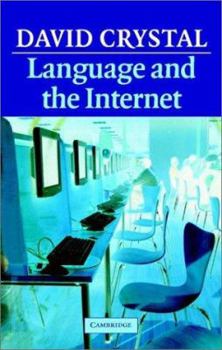Language and the Internet
Select Format
Select Condition 
Book Overview
According to popular mythology, the Internet will be bad for the future of language--technospeak will rule, standards will be lost, and creativity diminished as globalization imposes sameness. David... This description may be from another edition of this product.
Format:Hardcover
Language:English
ISBN:0521802121
ISBN13:9780521802123
Release Date:September 2001
Publisher:Cambridge University Press
Length:282 Pages
Weight:1.10 lbs.
Dimensions:0.9" x 5.7" x 8.8"
Related Subjects
Alphabet Computer Science Computers Computers & Technology Human-Computer Interaction Humanities Internet & Education Language Arts Languages & Tools Linguistics Programming Programming Languages Software Textbooks Words, Language & Grammar Writing Writing, Research & Publishing GuidesCustomer Reviews
1 rating
New Styles for the New Medium
Published by Thriftbooks.com User , 22 years ago
Look at that next e-mail from someone you consider intelligent, and maybe you will see that little regard is paid to exact spelling, to punctuation, even to using capital letters. Are we becoming illiterates by means of the amazing changes the Internet has brought? Dr. David Crystal, who has produced many scholarly volumes such as _The Cambridge Encyclopedia of the English Language_, uses the internet a lot, and has looked into the many forms of its use by other people. It is changing things, surely, but it is its own new medium drastically different from anything that has gone before, and Crystal says, "It shows language expanding richly in all sorts of directions." In _Language and the Internet_ (Cambridge University Press), Crystal surveys the language used in different branches of the Internet, and although he admits that some of his findings are going to be quickly dated because of the Internet's extreme rate of change, his book is a useful initial survey of Internet language, one upon which future studies will draw as a foundation.The remarkable function of the Internet in linguistic communication stems from its not quite being speech and not quite being writing. Communication in chatgroups or MUD's, and to a lesser extent e-mail, is typed but is a good deal like speech, displaying the immediacy and flow of conversation. This is an entirely new way of communicating. It means that John's speech is typed one keystroke at a time, but appears to recipients all of a piece, with no way that a recipient can react to it while it is being typed. Unlike with speech, the sender cannot be clued by an "Uh-huh" to indicate that the speech in progress is being well received. The speed of such interactions, dependent on keystrokes and speed of the Internet at that particular time, means that the rhythm of interaction is not only slow, but irregularly and unpredictably so. If there are multiple users, everyone's speech is displayed along with everyone else's, with little of the ear's ability to tune into just one speaker. Taking turns in conversation, which we take for granted face-to-face or on the telephone, is disrupted, and no one can get cues from tone of voice. Crystal reviews many of the responses Internet users have developed to deal with the peculiarities of the new medium. There is a list of the famous "smileys" or "emoticons" which are punctuation marks used to simulate smiling faces, frowning faces, confusion, winking, and so on. Their linguistic interest is that they could have shown up earlier in written language; only with the immediacy of Net communication did smileys become a useful tool. He reviews ways in which content of this form of communication may be shaped by the new medium, and is dismissive of the current crop of style manuals that would impose rules on it. This is an academic review, well referenced and footnoted, but Crystal's optimism and good humor abound. He has clarified many aspects of the styles and abbrevi




